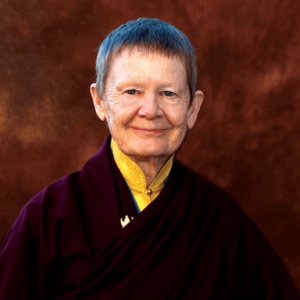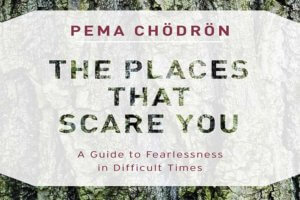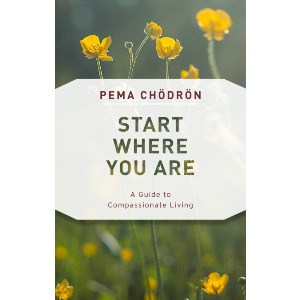As a species, we should never underestimate our low tolerance for discomfort. To be encouraged to stay with our vulnerability is news that we can use. Sitting meditation is our support for learning how to do this. Sitting meditation, also known as mindfulness-awareness practice, is the foundation of bodhichitta training. It is the natural seat, the home ground of the warrior-bodhisattva.
Sitting meditation cultivates loving-kindness and compassion, the relative qualities of bodhichitta. It gives us a way to move closer to our thoughts and emotions and to get in touch with our bodies. It is a method of cultivating unconditional friendliness toward ourselves and for parting the curtain of indifference that distances us from the suffering of others. It is our vehicle for learning to be a truly loving person.
Gradually, through meditation, we begin to notice that there are gaps in our internal dialogue. In the midst of continually talking to ourselves, we experience a pause, as if awakening from a dream. We recognize our capacity to relax with the clarity, the space, the open-ended awareness that already exists in our minds. We experience moments of being right here that feel simple, direct, and uncluttered.
This coming back to the immediacy of our experience is training in unconditional bodhichitta. By simply staying here, we relax more and more into the open dimension of our being. It feels like stepping out of a fantasy world and discovering the simple truth.
Yet there is no guarantee that sitting meditation will be of benefit. We can practice for years without its penetrating our hearts and minds. We can use meditation to reinforce our false beliefs: it will protect us from discomfort; it will fix us; it will fulfill our hopes and remove our fears. This happens because we don’t properly understand why we are practicing.
Why do we meditate? This is a question we’d be wise to ask. Why would we even bother to spend time alone with ourselves?
First of all, it is helpful to understand that meditation is not just about feeling good. To think that this is why we meditate is to set ourselves up for failure. We’ll assume we are doing it wrong almost every time we sit down: even the most settled meditator experiences psychological and physical pain. Meditation takes us just as we are, with our confusion and our sanity. This complete acceptance of ourselves as we are is called maitri, a simple, direct relationship with the way we are.
It feels like stepping out of a fantasy world and discovering the simple truth.
Trying to fix ourselves is not helpful. It implies struggle and self-denigration. Denigrating ourselves is probably the major way that we cover over bodhichitta.
Does not trying to change mean we have to remain angry and addicted until the day we die? This is a reasonable question. Trying to change ourselves doesn’t work in the long run because we’re resisting our own energy. Self-improvement can have temporary results, but lasting transformation occurs only when we honor ourselves as the source of wisdom and compassion. We are, as the eighth-century Buddhist master Shantideva pointed out, very much like a blind person who finds a jewel buried in a heap of garbage. Right here in what we’d like to throw away, in what we find repulsive and frightening, we discover the warmth and clarity of bodhichitta.
It is only when we begin to relax with ourselves that meditation becomes a transformative process. Only when we relate with ourselves without moralizing, without harshness, without deception, can we let go of harmful patterns. Without maitri, renunciation of old habits becomes abusive. This is an important point.
There are four qualities of maitri that are cultivated when we meditate: steadfastness, clear seeing, experiencing our emotional distress, and attention to the present moment. These qualities not only apply to sitting meditation but are essential to all the bodhichitta practices and for relating with difficult situations in our daily lives.
Steadfastness. When we practice meditation we are strengthening our ability to be steadfast with ourselves. No matter what comes up—aching bones, boredom, falling asleep, or the wildest thoughts and emotions—we develop a loyalty to our experience. Although plenty of meditators consider it, we don’t run screaming out of the room. Instead we acknowledge that impulse as thinking, without labeling it right or wrong. This is no small task. Never underestimate our inclination to bolt when we hurt.
We’re encouraged to meditate every day, even for a short time, in order to cultivate this steadfastness with ourselves. We sit under all kinds of circumstances—whether we are feeling healthy or sick, whether we’re in a good mood or depressed, whether we feel our meditation is going well or is completely falling apart. As we continue to sit we see that meditation isn’t about getting it right or attaining some ideal state. It’s about being able to stay present with ourselves. It becomes increasingly clear that we won’t be free of self-destructive patterns unless we develop a compassionate understanding of what they are.
One aspect of steadfastness is simply being in your body. Because meditation emphasizes working with your mind, it’s easy to forget that you even have a body. When you sit down it’s important to relax into your body and to get in touch with what is going on. Starting with the top of your head, you can spend a few minutes bringing awareness to every part of your body. When you come to places that are hurting or tense you can breathe in and out three or four times, keeping your awareness on that area. When you get to the soles of your feet you can stop, or if you feel like it, you can repeat this body sweep by going from bottom to top. Then at any time during your meditation period, you can quickly tune back in to the overall sense of being in your body. For a moment you can bring your awareness directly back to being right here. You are sitting. There are sounds, smells, sights, aches; you are breathing in and out. You can reconnect with your body like this when it occurs to you—maybe once or twice during a sitting session. Then return to the technique.
In meditation we discover our inherent restlessness. Sometimes we get up and leave. Sometimes we sit there but our bodies wiggle and squirm and our minds go far away. This can be so uncomfortable that we feel it’s impossible to stay. Yet this feeling can teach us not just about ourselves but also about what it is to be human. All of us derive security and comfort from the imaginary world of memories and fantasies and plans. We really don’t want to stay with the nakedness of our present experience. It goes against the grain to stay present. These are the times when only gentleness and a sense of humor can give us the strength to settle down.
As we continue to sit we see that meditation isn’t about getting it right or attaining some ideal state. It’s about being able to stay present with ourselves.
The pith instruction is, Stay . . . stay . . . just stay. Learning to stay with ourselves in meditation is like training a dog. If we train a dog by beating it, we’ll end up with an obedient but very inflexible and rather terrified dog. The dog may obey when we say “Stay!” “Come!” “Roll over!” and “Sit up!” but he will also be neurotic and confused. By contrast, training with kindness results in someone who is flexible and confident, who doesn’t become upset when situations are unpredictable and insecure.
So whenever we wander off, we gently encourage ourselves to “stay” and settle down. Are we experiencing restlessness? Stay! Discursive mind? Stay! Are fear and loathing out of control? Stay! Aching knees and throbbing back? Stay! What’s for lunch? Stay! What am I doing here? Stay! I can’t stand this another minute! Stay! That is how to cultivate steadfastness.
Share
Related Books
$16.95 - Paperback
$17.95 - Paperback
$19.95 - Paperback
$16.95 - Paperback
$24.95 - Hardcover








